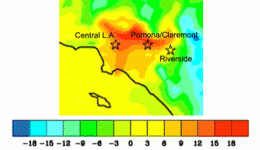Warming climate means harsher smog season for California

(PhysOrg.com) -- Rising temperatures from climate change will increase ozone levels in California’s major air basins, according to a new report to the California Air Resources Board from scientists at UC Davis and UC Berkeley.
The study also predicts that peak concentrations of dangerous airborne particles will increase in the San Joaquin Valley due to the effects of climate change on wind patterns.
“Our study reveals that climate change and regional air pollution are intertwined problems," said Michael Kleeman, professor of civil and environmental engineering at UC Davis and lead author of the study. "We must consider climate change and air pollution together as we plan for the future.”
The new study provides evidence of what is becoming known as the “climate penalty,” in which rising temperatures increase ground-level ozone and airborne health-damaging particles, despite the reductions achieved by programs targeting smog-forming emissions from cars, trucks and industrial sources.
“We already know that climate change will bring us increased forest fires, shorter winters, hotter summers and impact our water supply,” said Mary D. Nichols, chair of the Air Resources Board. “Now we have scientific evidence that higher temperatures are hurting our lungs, too. To protect public health, we need to take cost-effective measures to slash greenhouse gases now and continue to ratchet down all sources of smog-forming emissions and harmful soot and particles.”
Kleeman and his co-authors found that California could experience as many as six to 30 more days when ozone concentrations exceed federal clean-air standards, depending on the extent of increased temperatures and assuming that pollutant emissions in California remain at 1990-2004 levels.
The researchers predicted the effects of climate change on California regions by merging the results from large-scale global models with detailed models for the South Coast and San Joaquin Valley. These detailed models utilize high-resolution information about the regions’ geography, meteorology and emissions.
Failure in the future to reduce ozone and particulate matter to federally required levels could lead to the loss of transportation funds used by the state to maintain and develop roadways.
On a positive note, the study also found that climate change would decrease average annual particulate matter concentrations in coastal regions of the state.
“California’s interests are best served by taking a broad scientific view of climate change and air pollution together,” said Bart Croes, research division chief for the Air Resources Board. “Programs to protect California’s public health from the linked threats of global warming and air pollution need the guidance of the best science available, which is certainly exemplified by this study."
Kleeman's co-authors on the study are Shu-Hua Chen, assistant professor in the UC Davis Department of Land, Air and Water Resources, and Robert Harley, professor in the UC Berkeley Department of Civil and Environmental Engineering.
The study was funded by the California Air Resources Board, a department of the California Environmental Protection Agency. The board oversees all air pollution control efforts in California to attain and maintain health-based air quality standards.
More information: The full report and an executive summary are available at: www.arb.ca.gov/research/apr/past/climate.htm
















